Vallisneria Americana, also known as wild celery, is a popular aquatic plant that adds a touch of grace and beauty to aquariums.
In this comprehensive guide, we will explore everything you need to know about the care and maintenance of Vallisneria Americana.
From its natural habitat to its physical characteristics, lighting and water requirements, substrate needs, and propagation tips, we will provide you with all the information you need to cultivate and enjoy this stunning plant in your aquarium successfully. Let’s dive in and discover the underwater grace of Vallisneria Americana.
Key Takeaway
- Vallisneria Americana, also known as wild celery, is a graceful aquatic plant for aquariums.
- Understand the plant’s taxonomy and classification to successfully cultivate and maintain it.
- Vallisneria Americana is native to North America and thrives in freshwater environments.
- It has long ribbon-like leaves, a light green color, and small white flowers.
- Provide adequate lighting, water parameters, and substrate for optimal growth.
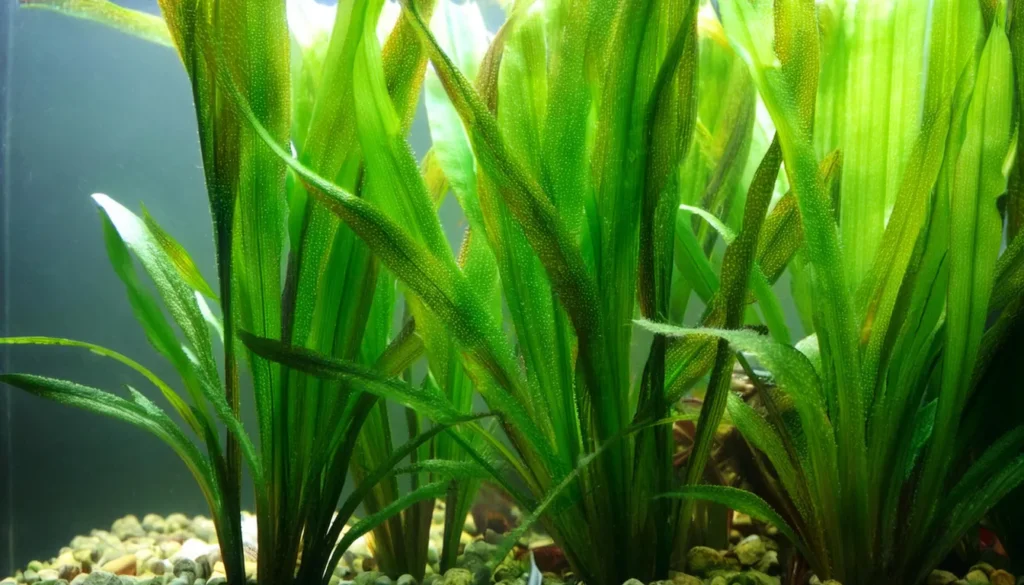
Quick Stats
| Attribute | Details |
| Scientific Name | Vallisneria americana |
| Common Name | American Vallisneria, Tape Grass |
| Origin | Native to North and Central America |
| Height | 30-120 cm (12-47 inches) |
| pH Range | 6.5 – 8.5 |
| CO2 Requirement | Low to Medium |
| Growth Rate | Moderate to Fast |
| Care Level | Easy |
| Color Form | Green |
| Water Conditions | 18-28°C (64-82°F), adaptable to various water parameters |
| Max Size | Typically reaches up to 120 cm (47 inches) in height |
| Lighting | Low to Moderate |
| Supplements | Root tabs or liquid fertilizers beneficial |
| Placement | Background |
| Propagation | Through runners or division of rhizome |
What Is Vallisneria Americana?
Vallisneria Americana, also known as wild celery or tape grass, is a species of rooted aquatic plant native to North America. It belongs to the family Hydrocharitaceae and the genus Vallisneria.
This species is highly popular among aquarium enthusiasts due to its long, ribbon-like leaves and graceful appearance.
They are widely recognized for their important ecological role in providing habitat for aquatic organisms and contributing to water quality improvement.
Understanding the taxonomy and classification of Vallisneria Americana is essential for successfully cultivating and maintaining this plant in a home aquarium.
Vallisneria Americana, also known as wild celery or tape grass, is a species of rooted aquatic plant native to North America.
It belongs to the family Hydrocharitaceae and the genus Vallisneria.
This species is highly popular among aquarium enthusiasts due to its long, ribbon-like leaves and graceful appearance.
RELATED: Embracing The Beauty Of Salvinia Natans In Aquascapes
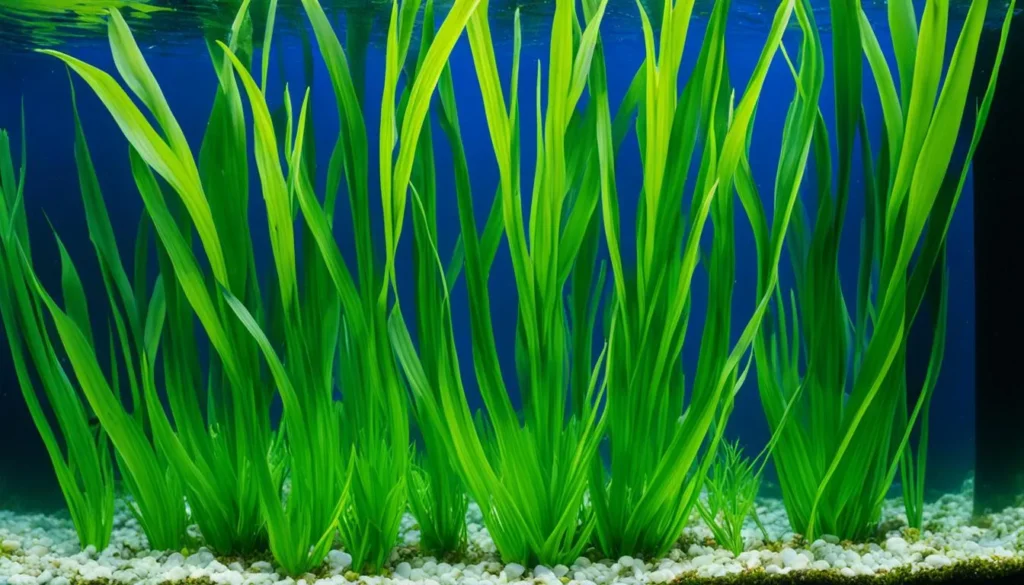
Natural Habitat And Origin
In its natural habitat, Vallisneria Americana can be found in freshwater environments such as rivers, lakes, and streams across North America.
This beautiful aquatic plant has a wide distribution, spanning from Canada to Mexico.
However, it is particularly abundant in the Chesapeake Bay region, where it thrives and plays a crucial role in the ecosystem.
Their natural habitat provides essential food and shelter for various aquatic species, contributing to the overall biodiversity of the region.
The plant’s long, ribbon-like leaves offer hiding places and protective cover for small fish, invertebrates, and aquatic organisms, ensuring their survival and well-being.
Understanding the natural habitat and origin of Vallisneria Americana is crucial for cultivating and maintaining this plant in a home aquarium.
By recreating the optimal conditions found in its natural environment, such as appropriate lighting, water parameters, and substrate, aquarists can provide their tape grass with a conducive environment for growth and development.
Physical Characteristics
- Vallisneria Americana, also known as wild celery, possesses distinct physical characteristics contributing to its captivating appearance in aquariums. This aquatic plant showcases long and slender ribbon-like leaves, which can grow up to several feet in length. The leaves, with their light green color, create an elegant and refreshing aesthetic in the underwater environment.
- Supported by delicate stems that emerge from the substrate, wild celery leaves also feature a striking light green stripe running down their center, adding depth and visual interest to the plant. This unique attribute sets them apart from other aquatic plants and serves as an identifying characteristic.
Lighting Requirements Of The Plant
- Vallisneria Americana is a stunning aquarium plant that requires adequate lighting for optimal growth and development. Providing the right amount of light is essential to ensure the plant’s lush and healthy growth.
- In a home aquarium setting, it is recommended to use full-spectrum aquarium lights or LED lights specifically designed for plant growth. These lights emit the wavelengths essential for photosynthesis and promote the plant’s overall health.
- The recommended light intensity for Vallisneria Americana is around 2 to 3 watts per gallon. This will ensure that the plant receives sufficient light energy for its metabolic processes and growth. It is important to note that insufficient light may lead to stunted growth and reduced vitality.
- Another important factor to consider is the photoperiod, which refers to the duration of light exposure. To mimic the natural day-night cycles, providing a photoperiod of 10 to 12 hours of light per day is recommended. This allows the plant to undergo necessary physiological processes and rest periods, promoting overall health and growth.

Water Parameters For Optimal Growth
- Maintaining pH Levels: Vallisneria Americana prefers slightly alkaline to neutral water conditions, with a pH range of 6.5 to 7.5. Keeping the pH within this range helps create a favorable plant growth environment. Monitoring the pH regularly and making necessary adjustments will ensure that your tape grass thrives.
- Temperature Requirements: The water temperature plays a vital role in the growth and well-being of wild celery. Maintaining a temperature between 72°F and 82°F provides the plant with optimal conditions for growth. Fluctuations in temperature should be avoided, as they can negatively impact the plant’s development.
- Water Hardness: Vallisneria Americana is adaptable when it comes to water hardness. However, maintaining a general range of 3 to 8 dGH is recommended for its optimal growth. Regularly testing the water hardness and adjusting as needed will help ensure the plant’s health and vitality.
- Maintain Water Quality: To create a stable and clean water environment for wild celery, monitoring and maintaining water quality is essential. Regular water changes, filtration, and maintaining appropriate nutrient levels are important to prevent any detrimental impacts on the plant’s growth. Ensuring a stable and clean water environment will promote the health and vibrancy of Vallisneria Americana.

Temperature Needs Of The Plant
- Understanding the temperature requirements for Vallisneria Americana is crucial for its successful growth and overall well-being in the aquarium. This beautiful aquatic plant thrives in tropical to subtropical temperatures, replicating its natural habitat. Providing the right water temperature is essential to create an optimal environment for Vallisneria Americana.
- Vallisneria Americana requires a water temperature between 72°F and 82°F for optimal growth. This temperature range ensures that the plant remains within its preferred temperature zone, avoiding any stress or adverse effects. Consistent temperature fluctuations can harm the growth and health of Vallisneria Americana, leading to reduced growth rates or even plant death.
Substrate Requirements
- Vallisneria Americana, being a nutrient-demanding plant, requires a suitable substrate for optimal growth and development. The choice of substrate plays a crucial role in providing essential nutrients to support the plant’s root system.
- A fine-grained substrate, such as sand or fine gravel, is highly recommended for Vallisneria Americana. This type of substrate allows the plant’s roots to anchor firmly and spread easily, promoting healthy growth.
- It is important to ensure that the substrate is well-drained to avoid waterlogged conditions, as Vallisneria Americana prefers moderate water flow. Excessive moisture retention can lead to root rot and hinder the plant’s growth and overall health.
Placement Option
- Deciding where to position Vallisneria Americana in the aquarium is crucial for creating a visually appealing and balanced aquascape. The placement options for Vallisneria Americana depend on its size and growth habit.
- As a foreground plant, Vallisneria Americana can be positioned in the front or side areas of the tank. Placing it in the foreground creates a visual focal point and draws attention to its elegant ribbon-like leaves. This placement option works well in smaller aquariums, allowing the beauty of Vallisneria Americana to take center stage.
- Alternatively, Vallisneria Americana can be placed in the background of the aquarium. This positioning adds height and depth to the aquascape, creating a lush and vibrant underwater landscape. The long leaves of Vallisneria Americana sway gracefully in the water, providing a sense of movement and natural beauty.
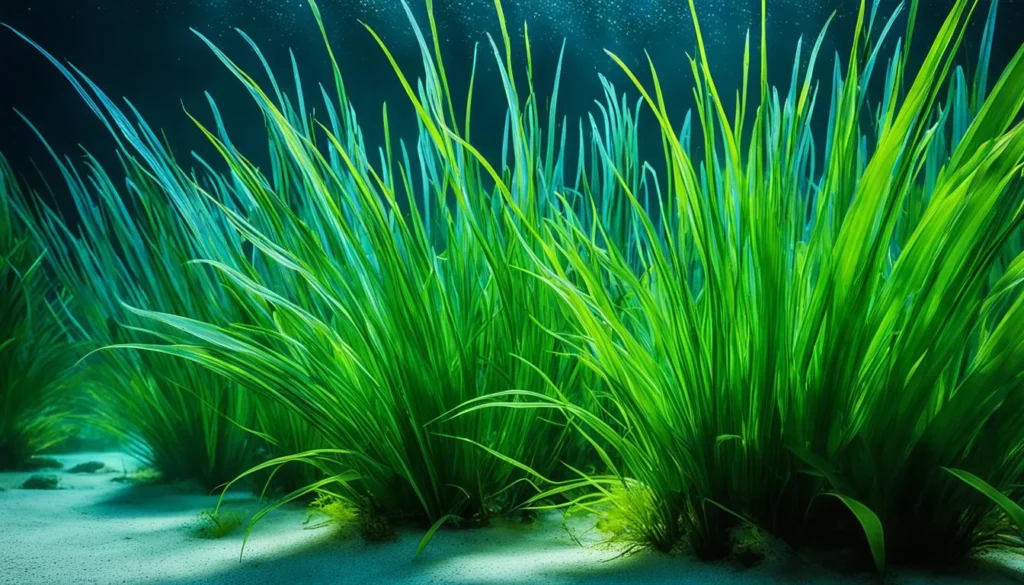
Recommended Tank Size
- Determining the appropriate tank size for Vallisneria Americana is essential for creating a thriving and visually appealing aquatic environment. While this versatile plant can be grown in various tank sizes, it’s important to consider its growth potential and provide adequate space.
- For smaller tanks, such as nano aquariums, it is recommended to regularly trim and control the growth of Vallisneria Americana to prevent it from overshadowing other plants or occupying excessive space. This ensures a balanced and visually pleasing aquascape.
Suitable Tank Mates For Vallisneria Americana
When setting up an aquarium with Vallisneria Americana, it’s important to consider the compatibility of the plant with other fish and invertebrates.
Vallisneria Americana provides beneficial hiding places and spawning sites, making it an excellent choice for a community aquarium.
Some suitable tank mates for Vallisneria Americana include:
- Tetras
- Gouramis
- Rasboras
- Corydoras catfish (bottom-dwelling fish)
- Snails
- Shrimp
These peaceful community fish and invertebrates can coexist harmoniously with Vallisneria Americana.
The plant provides them with shelter and food sources, creating a natural and symbiotic aquarium environment.
Nutritional Requirements Of The Plant
- Vallisneria Americana requires several essential nutrients for healthy growth. These include macronutrients such as nitrogen, phosphorus, and potassium, which are necessary for the plant’s overall development. Macronutrients can be supplied through liquid fertilizers or root tabs specifically formulated for aquatic plants like Vallisneria Americana. These fertilizers provide a balanced combination of nutrients and promote robust growth.
- In addition to macronutrients, Vallisneria Americana also benefits from the presence of micronutrients. Micronutrients, such as iron, magnesium, and calcium, play vital roles in plant metabolic processes. Iron is especially important for chlorophyll production, which is essential for photosynthesis. Magnesium is crucial for enzyme activation and serves as a building block for chlorophyll molecules. Calcium is necessary for cell wall development, structural integrity, and nutrient absorption.
- To ensure a balanced and nutrient-rich environment for Vallisneria Americana, it is important to regularly monitor the nutrient levels in the aquarium water. Testing kits can be used to measure the concentrations of nitrate, phosphate, potassium, and other essential elements. Based on the test results, nutrient supplementation can be adjusted accordingly to meet the plant’s requirements.
| Nutrient | Function | Source |
| Nitrogen | Essential for plant growth and chlorophyll production | Liquid fertilizers, root tabs |
| Phosphorus | Required for energy transfer and root development | Liquid fertilizers, root tabs |
| Potassium | Regulates water balance and supports overall plant health | Liquid fertilizers, root tabs |
| Iron | Crucial for chlorophyll production and photosynthesis | Iron supplements, iron-rich substrates |
| Magnesium | Activates enzymes and contributes to chlorophyll production | Magnesium supplements, Epsom salt |
| Calcium | Supports structural development and nutrient absorption | Calcium-rich substrates, calcium carbonate |
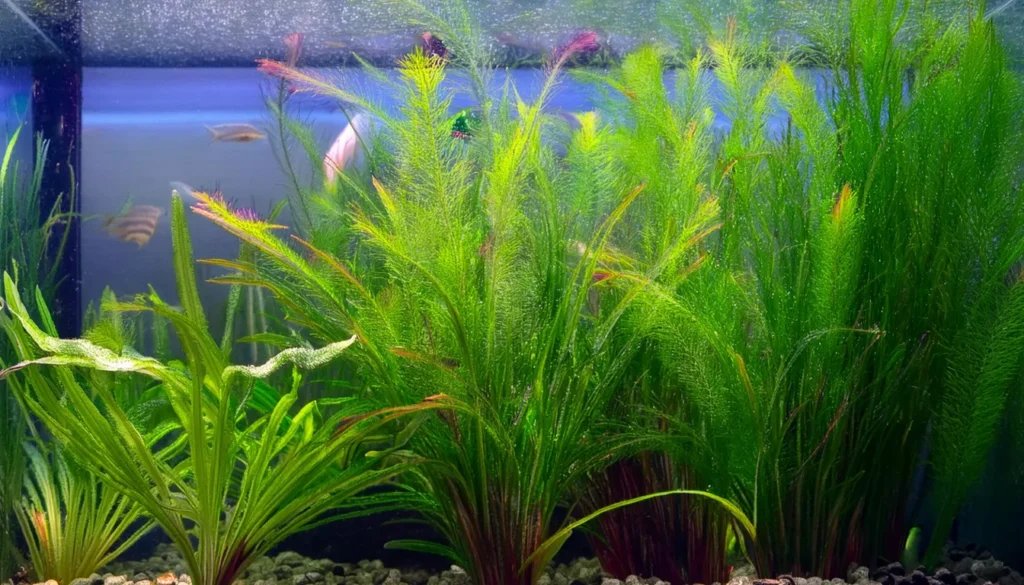
Essential Aquatic Plant Maintenance
- Regular maintenance is crucial for ensuring the health and vitality of Vallisneria Americana. By performing essential tasks, you can promote healthy growth, maintain water quality, and prevent issues such as overcrowding and algae growth.
- One important maintenance task is pruning. As Vallisneria Americana is a fast-growing plant, regular trimming helps prevent it from taking over the aquarium. Pruning also promotes the development of new shoots and encourages healthy growth.
- Removing dead leaves is another crucial maintenance task. Dead leaves can degrade water quality and provide a breeding ground for harmful bacteria. By removing them promptly, you can ensure a cleaner and healthier environment for your Vallisneria Americana.
- Controlling algae growth is also necessary for maintaining the health of Vallisneria Americana. Algae can compete with the plant for nutrients and light, hindering its growth. Regular cleaning, proper lighting, and maintaining appropriate nutrient levels can help prevent excessive algae growth.
- Keeping the aquarium clean and free from debris is essential for the overall well-being of Vallisneria Americana. Regular water changes, substrate vacuuming, and filter maintenance help remove accumulated waste and maintain optimal water conditions.
| Maintenance Tasks | Benefits |
| Pruning | Promotes healthy growth, prevents overcrowding |
| Removing dead leaves | Maintains water quality, prevents bacterial growth |
| Controlling algae growth | Prevents competition for nutrients and light |
| Cleaning the aquarium | Removes debris and waste, maintains optimal conditions |
| Maintaining water parameters | Ensures ideal conditions for growth and health |
| Nutrient supplementation | Promotes robust growth and vibrant colors |
Cultivating Vallisneria Americana At Home
- Choose a Suitable Tank: Select a tank that provides ample space for wild celery to grow and spread its long ribbon-like leaves. Consider the growth potential of the plant and choose a tank size accordingly.
- Provide Appropriate Lighting: Vallisneria Americana thrives under moderate to high light levels. Use full-spectrum aquarium lights or LED lights specifically designed for plant growth. Aim for a light intensity of 2 to 3 watts per gallon and provide a photoperiod of 10 to 12 hours daily.
- Choose the Right Substrate: Opt for a fine-grained substrate such as sand or fine gravel. Ensure that the substrate is well-drained to prevent waterlogged conditions, and supplement it with root tabs or liquid fertilizers to provide essential nutrients for the plant.
- Maintain Optimal Water Parameters: Keep the water pH between 6.5 and 7.5 for wild celery’s optimal growth. The water temperature should range from 72°F to 82°F, and the water hardness should be within a general range of 3 to 8 dGH. Regularly monitor water quality and perform necessary maintenance tasks to maintain stable and clean water conditions.
- Select Compatible Tank Mates: Consider the compatibility of other fish and invertebrates in your aquarium with Vallisneria Americana. Ensure that they are peaceful and won’t damage the plant. Some suitable tank mates include tetras, gouramis, rasboras, corydoras, catfish, snails, and shrimp.
Plant Propagation Tips
- Runners: Runners are small shoots that emerge from the parent plant. These runners develop into new plants that can be separated from the parent and replanted in the substrate. By allowing the runners to establish roots, you can create new clusters of Vallisneria Americana plants in your aquarium.
- Rhizome Division: Rhizome division involves separating the plant’s rhizomes and planting them individually. Rhizomes are horizontal stems that grow underground and produce new shoots and roots. By carefully dividing the rhizomes, you can create multiple independent plants that will continue to grow and spread.
- Seed Germination: Seed germination can be a challenging but rewarding method of propagating Vallisneria Americana. Collect mature seeds from the plant and ensure they are fully submerged in the aquarium. The seeds require specific germination conditions, including proper lighting, temperature, and nutrient levels. Successful germination will result in new plants emerging from the seeds.
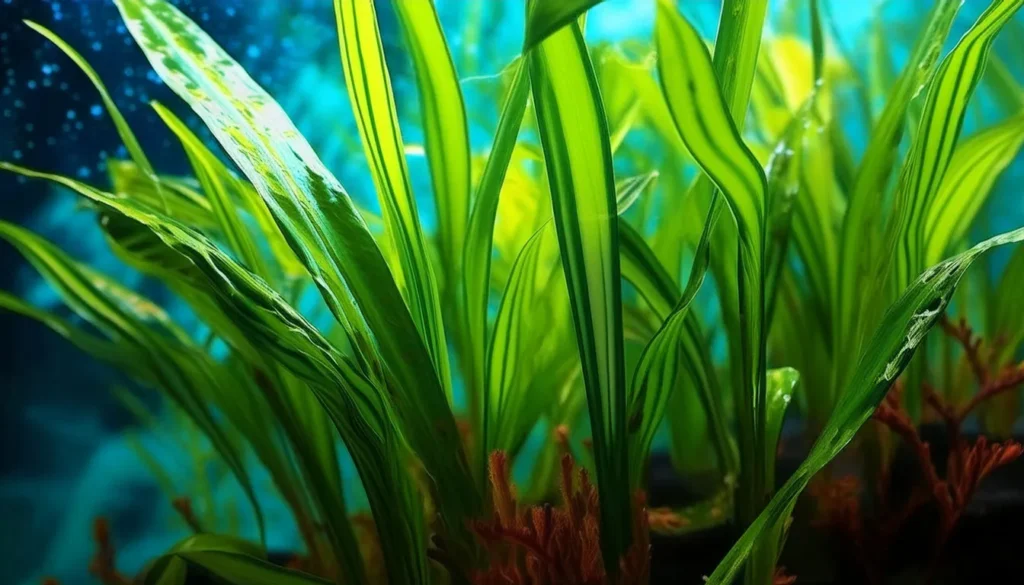
Benefits Of Planting Vallisneria Americana
- Regarding aquarium plants, they offer numerous benefits, making it a valuable addition to any aquatic environment. From providing shelter and hiding places for fish and invertebrates to contributing to water quality improvement, this plant enhances your aquarium’s overall health and aesthetics.
- Wild celery creates a natural and harmonious environment by offering shelter and hiding places for fish and invertebrates. These spaces provide a sense of security for aquatic organisms and encourage natural behaviors and interactions. For shy or timid species, such as small Tetras or freshwater shrimps, Vallisneria Americana provides valuable retreats and safe spaces to help reduce stress levels.
- This plant also plays a vital role in maintaining water quality by absorbing excess nutrients and inhibiting algae growth. They absorbs nutrients such as nitrates and phosphates from the water, competing with algae for these resources. Doing so helps reduce the risk of excessive algae blooms that can negatively impact water clarity and the health of aquatic organisms.
Conclusion
Vallisneria Americana is a striking aquatic plant that brings underwater grace and beauty to any aquarium.
You can cultivate this plant by providing the right care, lighting, water parameters, and maintenance and enjoy its lush growth and elegant appearance.
Whether you’re a beginner or an experienced aquarist, incorporating wild celery into your aquarium offers a rewarding experience that enhances both the health and aesthetics of your aquatic environment.
RELATED: Peacock Moss (Taxiphyllum sp.)Planting And Caring Guide For Beginners
With its long ribbon-like leaves and distinctive features, wild celery creates a captivating underwater landscape.
By replicating its natural habitat and providing the right lighting and water conditions, you can create a visually stunning aquascape that showcases the beauty of this plant.
This versatile plant can be placed as a foreground or background plant, adding depth and character to your aquarium.
Not only does it enhances the visual appeal of your aquarium, but it also provides important benefits.
Its capacity to absorb excess nutrients and reduce algae growth contributes to water quality improvement.
Additionally, it offers shelter and hiding places for fish and invertebrates, creating a natural and harmonious environment for your aquatic pets.
The oxygenation provided by Vallisneria Americana through photosynthesis further enhances aquatic organisms’ overall health and well-being.
Frequently Asked Questions
What Are Suitable Tank Mates For Vallisneria Americana?
Suitable tank mates for Vallisneria Americana include peaceful community fish like tetras, gouramis, and rasboras.
Bottom-dwelling fish such as corydoras catfish can also coexist harmoniously. Invertebrates like snails and shrimp can benefit from the shelter and food sources provided by wild celery.
What Are The Nutritional Requirements Of Vallisneria Americana?
Vallisneria Americana requires macronutrients such as nitrogen, phosphorus, and potassium, which can be supplied through liquid fertilizers or root tabs.
Micronutrients like iron, magnesium, and calcium are also beneficial. Balanced nutrient supplementation is important for the plant’s overall health and growth.
What Maintenance Tasks Are Needed For Vallisneria Americana?
Regular maintenance tasks for Vallisneria Americana include pruning, removing dead leaves, controlling algae growth, monitoring water quality, and performing regular water changes. These tasks ensure the plant’s health and vitality.
How Can Vallisneria Americana Be Propagated?
Vallisneria Americana can be propagated through runners, rhizome division, and seed germination. Runners can be separated from the parent plant and planted in the substrate. Rhizome division involves separating and planting individual rhizomes. Seed germination, although challenging, can result in new plants if successful.
What Are The Benefits Of Planting Vallisneria Americana In The Aquarium?
Planting Vallisneria Americana provides shelter, hiding places, and spawning sites for fish and invertebrates, contributing to a natural and harmonious aquarium environment.
It absorbs excess nutrients, reduces algae growth, and helps oxygenate the water, benefiting overall water quality. The elegant appearance of wild celery adds beauty to the aquarium.
- Unveiling The Wonders Of Riccia Fluitans In Aquascapes - August 7, 2024
- Vallisneria Gigantea Var. Guide To Care And Cultivation At Home - July 31, 2024
- Vesicularia Dubyana Care & Growth Guide Tips For Beginner Gardeners - July 30, 2024
